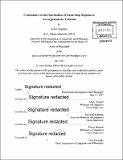| dc.contributor.advisor | Adam Albright, Edward Flemming, and Donca Steriade. | en_US |
| dc.contributor.author | Stanton, Juliet | en_US |
| dc.contributor.other | Massachusetts Institute of Technology. Department of Linguistics and Philosophy. | en_US |
| dc.date.accessioned | 2017-10-30T15:28:55Z | |
| dc.date.available | 2017-10-30T15:28:55Z | |
| dc.date.copyright | 2017 | en_US |
| dc.date.issued | 2017 | en_US |
| dc.identifier.uri | http://hdl.handle.net/1721.1/112041 | |
| dc.description | Thesis: Ph. D., Massachusetts Institute of Technology, Department of Linguistics and Philosophy, 2017. | en_US |
| dc.description | Cataloged from PDF version of thesis. | en_US |
| dc.description | Includes bibliographical references (pages 223-257). | en_US |
| dc.description.abstract | It has been argued that certain typological generalizations regarding the distribution of nasal-stop sequences can be explained by explicitly referencing contrast (e.g. Herbert 1977, 1986; Jones 2000). This thesis explores the hypothesis that all generalizations regarding the distribution of nasal-stop sequences can be explained by explicitly referencing contrast, and presents the results of multiple cross-linguistic studies designed to test that hypothesis. I show first that taking into consideration cues to the contrasts between nasal-stop sequences and their component parts (nasals and stops) allows us to accurately predict generalizations regarding the distribution of phonemic nasal-stop sequences (i.e. those that are phonemically contrastive with other segment types). Following this I show that taking into consideration cues to the contrast between oral and nasal vowels allows us to accurately predict generalizations regarding the distribution of allophonic nasal-stop sequences (i.e. those not phonemically contrastive with other segment types), as well as generalizations regarding the distribution of phonemic nasal-stop sequences in the context of phonemically nasal and allophonically nasalized vowels. Broadly, the results presented here contribute to a larger body of evidence that constraints on contrast are a necessary component of the synchronic phonological grammar (following e.g. Lindblom 1986; Flemming 2002, 2008b; Padgett 2009). | en_US |
| dc.description.statementofresponsibility | by Juliet Stanton. | en_US |
| dc.format.extent | 257 pages | en_US |
| dc.language.iso | eng | en_US |
| dc.publisher | Massachusetts Institute of Technology | en_US |
| dc.rights | MIT theses are protected by copyright. They may be viewed, downloaded, or printed from this source but further reproduction or distribution in any format is prohibited without written permission. | en_US |
| dc.rights.uri | http://dspace.mit.edu/handle/1721.1/7582 | en_US |
| dc.subject | Linguistics and Philosophy. | en_US |
| dc.title | Constraints on the distribution of nasal-stop sequences : an argument for contrast | en_US |
| dc.type | Thesis | en_US |
| dc.description.degree | Ph. D. | en_US |
| dc.contributor.department | Massachusetts Institute of Technology. Department of Linguistics and Philosophy | |
| dc.identifier.oclc | 1006385325 | en_US |
